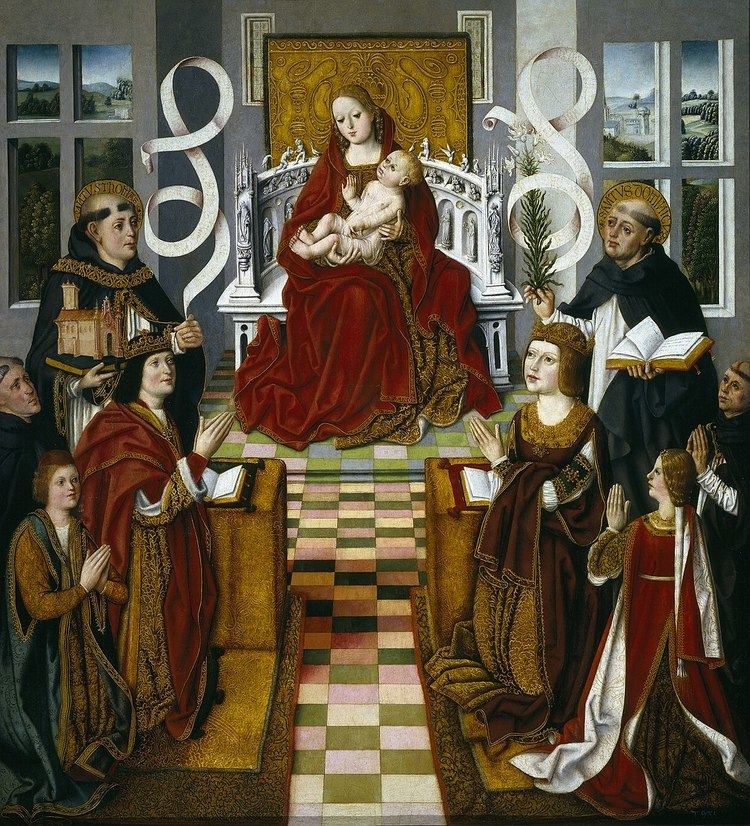 | ||
On October 19, 1469, Ferdinand II of Aragon married Isabella I of Castile. They were among the most powerful monarchs in all of early modern age Europe and their marriage produced many children, five of whom survived to adulthood. They arranged strategic political marriages for all of these children to powerful monarchs and well-connected women. In time, many of their grandchildren became emperors and kings of various countries, and their first and second generation of descendants caused the genealogical lines of Isabella I and Ferdinand II to spread throughout Europe.
The most famous living descendants of Isabella I and Ferdinand II are probably the current European monarchs. First of all, the Kings of Spain are descended from their union, with their current major dynastic heir being King Felipe VI of Spain, who reigns in their native territories. However, it is also the case that all the other monarchs currently reigning in Europe – King Albert II of Belgium, Grand-Duke Henri of Luxembourg, Queen Elizabeth II of the U.K., Queen Margrethe II of Denmark, King Harald V of Norway, King Carl XVI Gustaf of Sweden, and King Willem-Alexander of the Netherlands – descend from Isabella I and Ferdinand II. This is also true of the Sovereign Princes of Europe: Albert II, Prince of Monaco and Hans-Adam II, Prince of Liechtenstein.
Albert II of Belgium and Grand-Duke Henri of Luxembourg are, given the frequent intermarriage between Catholic dynasties, both descended from the medieval monarchs through multiple lines. The non-Catholic dynasties also share several lines of descent – the following are but a few examples. Elizabeth II of the U.K. descends from the Saxe-Coburg-Gotha family and that line descends from Isabella I and Ferdinand II beginning with the 1636 marriage of Princess Elisabeth Sophie of Saxe-Altenburg (1619–1680) to Ernest I, Duke of Saxe-Gotha (1601–1675) (Elisabeth Sophie being a descendant through Isabella and Ferdinand's daughter Joanna of Castile). Margrethe II of Denmark, Harald V of Norway, and Carl XVI Gustaf of Sweden also trace their mutual descent from Isabella I and Ferdinand II through that same line as Elizabeth II of the U.K. In addition, Margrethe II, Harald V, and Carl XVI Gustaf also trace their descent from the Iberian couple through Josephine of Leuchtenberg, Queen-consort to King Oscar I of Sweden. Josephine, like Queen Beatrix discussed in the following sentence, is descended from the Landgraves of Hesse-Darmstadt and that family is also descended from the Iberian couple. Beatrix of the Netherlands is descended from Isabella I and Ferdinand II through her great-great-great grandmother Wilhelmine of Prussia, wife of the first king of the Netherlands, William I. Queen Wilhelmine descends from the Landgraves of Hesse-Darmstadt and the Landgraves are descendants by virtue of the aforementioned 1636 marriage of Princess Elisabeth Sophie of Saxe-Altenburg and Ernest I, Duke of Saxe-Gotha (Elisabeth Sophie and Ernest I's daughter, Elisabeth Dorothea, married Louis VI, Landgrave of Hesse-Darmstadt).
The Landgraves of Hesse-Darmstadt connection also provides the descent of Albert II, Prince of Monaco from Isabella I and Ferdinand II. Prince Albert's great-great-great grandmother, Princess Marie of Baden, was in turn the granddaughter of Landgravine Amalie of Hesse-Darmstadt.
Hans-Adam II, Prince of Liechtenstein is descended from Isabella I and Ferdinand II through his grandmother, Archduchess Elisabeth Amalie of Austria; Elisabeth Amalie descends from the Iberian couple via the Spanish and Hesse-Darmstadt houses, as well as through the formerly-reigning Catholic imperial or royal houses of Austria-Hungary, Portugal, and Bavaria (these formerly-reigning houses all descend from Isabella I and Ferdinand II).
